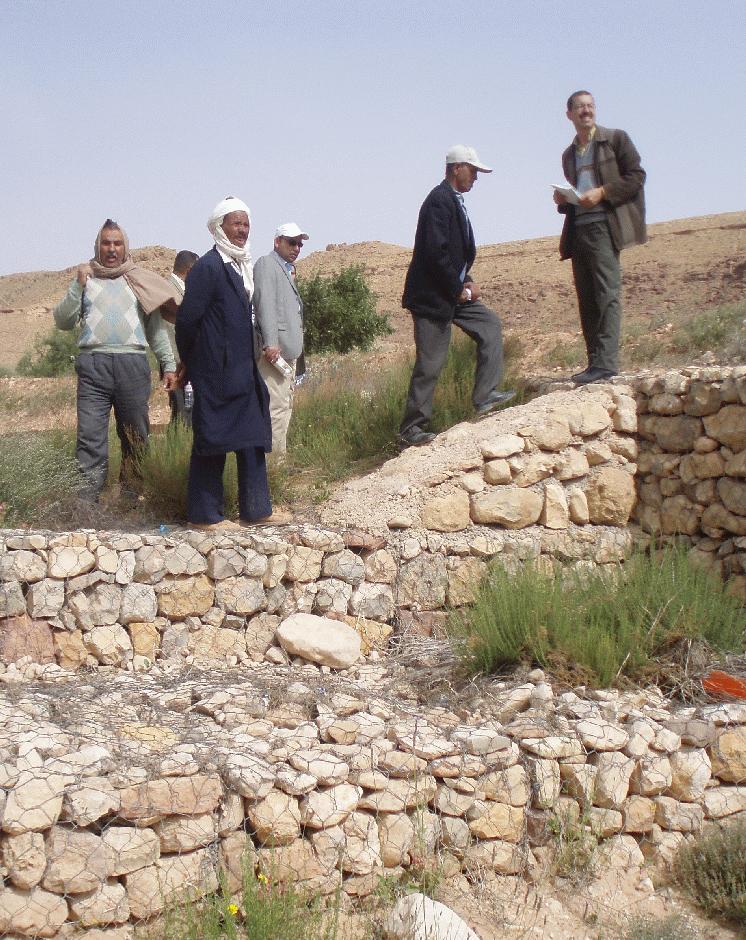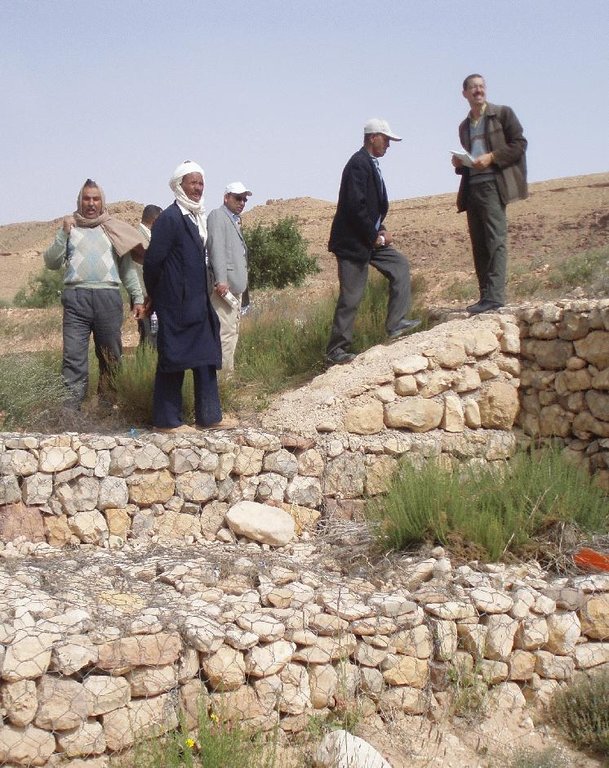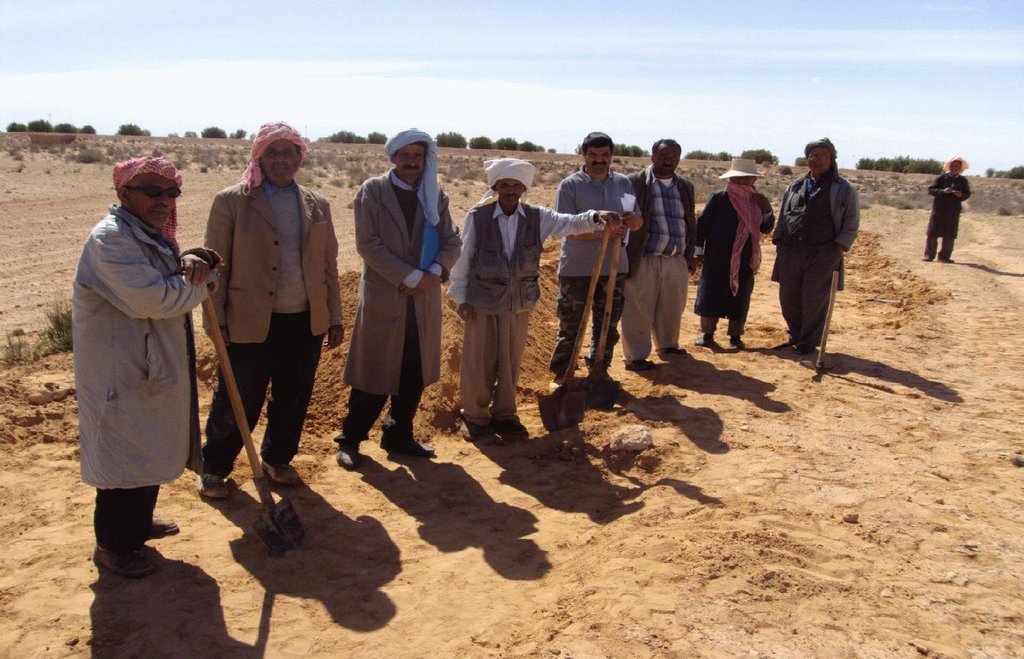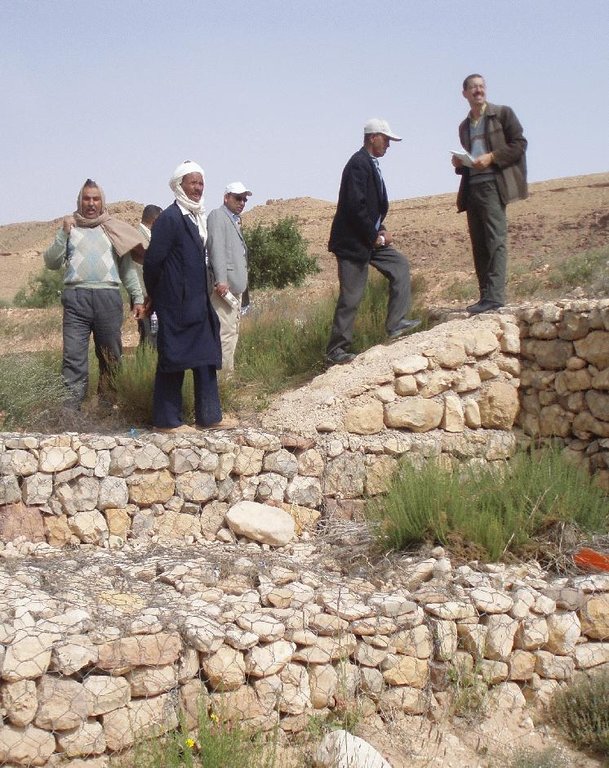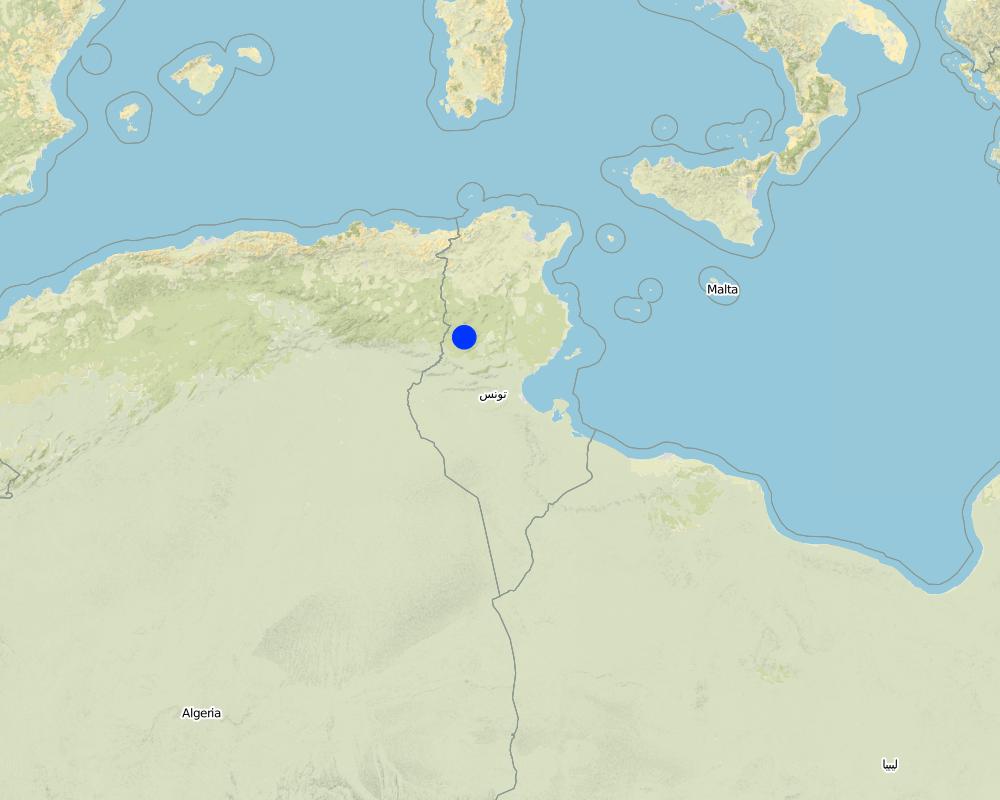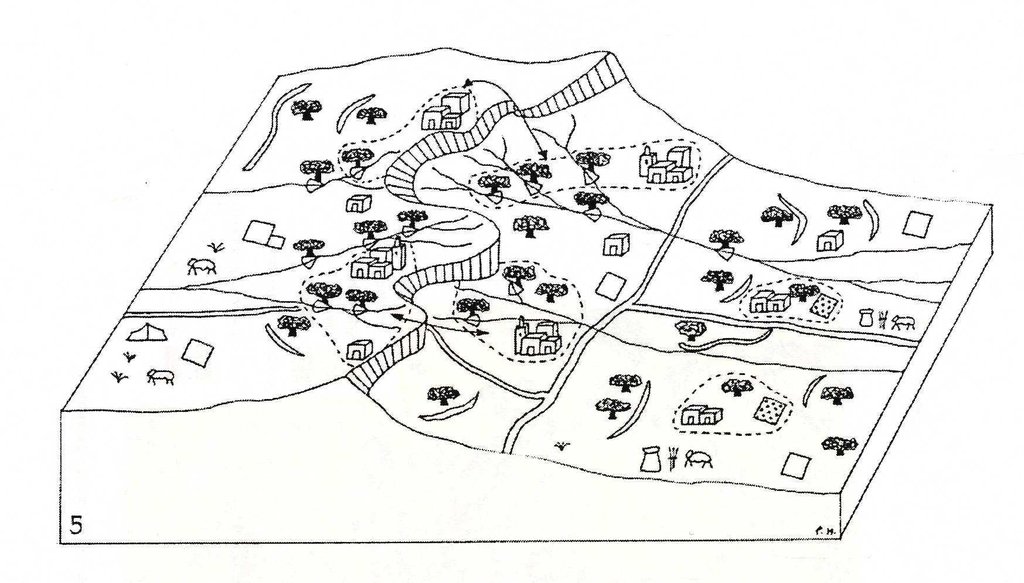Dryland watershed management approach [Тунис]
- Шинийг нээх:
- Шинэчлэх:
- Эмхэтгэгч: Naceur Mahdi
- Хянан тохиолдуулагч: –
- Хянагч: Fabian Ottiger
approaches_2422 - Тунис
Бүлгүүдийг үзэх
Бүгдийг дэлгэх Бүгдийг хаах1. Ерөнхий мэдээлэл
1.2 Арга барилыг баримтжуулах болон үнэлгээ хийхэд оролцсон хүн эсвэл байгууллагын холбоо барих хаяг
ГТМ мэргэжилтэн:
ГТМ мэргэжилтэн:
Sghaier Mongi
sghaier.mon@gmail.com
Institut des Régions Arides
4119 Medenine
Тунис
Арга барилыг баримтжуулах/үнэлэх ажилд дэмжлэг үзүүлсэн байгууллага(ууд)-ын нэр (шаардлагатай бол)
Institut des Régions Arides de Médenine (Institut des Régions Arides de Médenine) - Тунис1.3 WOCAT-аар баримтжуулсан өгөгдлийг ашиглахтай холбоотой нөхцөл
Эмхэтгэгч болон гол мэдээлэгч хүн(хүмүүс) WOCAT аргачлалаар баримтжуулсан мэдээллийг ашиглахтай холбоотой нөхцлийг хүлээн зөвшөөрсөн:
Тийм
1.4 ГТМ-ийн технологийн асуулгын(д) суурь мэдээлэл(д)
2. ГТМ Арга барилын тодорхойлолт
2.1 Арга барилын товч тодорхойлолт
Integrated land and water management approach, including vegetative, management, and agronomic measure
2.2 Арга барилын дэлгэрэнгүй тодорхойлолт
Арга барилын дэлгэрэнгүй тодорхойлолт:
Aims / objectives: The overall purpose of the approach is to prevent soil and water loss by combined measures and to provide a better environment. Soil and water conservation (SWC) technologies, based on harvesting area of surface water and underground water, are implemented to conserve soil and water and to improve the production and the biodiversity.
Methods: This approach is designed for the exploitation of water runoff for agricultural development, particularly for fruit trees cropping (mainly olives).This can be achieved through erosion reduction and aquifer recharge via runoff water infiltration into the terraces, slope angle and length reduction, runoff retaining, infiltration increase and soil loss reduction. The system is based on various runoff water harvesting systems, as jessour, tabias. It is marked by fruit tree development, notably olives. On the terraces, the fruit trees are arranged in inter-rows with the three main species encountered in the study areas. Generally, olive trees are planted, with in between rows almonds and/ or fig trees. SWC technologies play an importance role in arid zones. Since the 1970s, the Tunisian state has encouraged the local population to conserve water and soil in arid zone. Successive programmes and strategies of water and soil conservation have been developed and were implemented in all three natural regions of Tunisia (North, Centre and South).These techniques can be implemented by farmer with governmental subsidies or by government intervention in the projects and programmes of water and soil conservation. During the last decade, the Tunisian government implemented the first national strategy for soil and water conservation (1990-2000) and the second national strategy for soil and water conservation (2001-2011). These strategies mobilized important funds at national and regional levels. About 672.5 ha of SWC technologies were built and about 550 ha of SWC technologies are planned for the second national strategy.
Stages of implementation: 1) Assessment of the current natural resources and socio-economic conditions; 2) Proposition of actions at local and regional level; 3) Aggregation and coherence at the national level; 4) implementation of national action plan at local and regional level.
Role of stakeholders: Different levels of intervention are observed from the individual farm, through the community level, the extension / advisory system, the regional or national administration, or the policy level, to the international framework. The participative approach is usually applied in the construction of SWC technologies.
2.3 Арга барилын зурагууд
2.5 Арга барил нэвтрүүлсэн улс орон / бүс нутаг / байршил
Улс:
Тунис
Улс/аймаг/сум:
south-east of tunisia
Байршлын дэлгэрэнгүй тодорхойлолт:
Oum Zessar Watershed
Map
×2.6 Арга барилыг эхлэх, дуусах огноо
Эхлэх жилийг тэмдэглэ:
1960
2.7 Арга барилын төрөл
- Сүүлийн үеийн орон нутгийн санаачлага / шинэчлэл
2.8 Арга барилын үндсэн зорилго, зорилтууд
The Approach focused on SLM only (production, soil fertility, biodiversity, employement oppourtunities, food self-sufficiency, fixing population and stop farming exodus)
The objectives of the approach are to control soil and water loss to reduce floods and enhance fertility, to enhance rainfed agriculture productivity, to improve the livelihoods of farmers, to contribute to the production increase among farmers and pastoralists, to recharge the groundwater and to extend the area of cropland.
The SLM Approach addressed the following problems: The problems originate in the scarcity of water which is leading to conflicts over resource use between farmers. Oversized techniques leading to prevention of runoff from upstream to downstream reduce agricultural production and therefore the farm income, which causes a lack of cash to invest in SLM. In some cases irreversible land degradation is the result. The problems are mainly related to the lack of technical knowledge, the high costs of investment and the lack of tangible and assessable impacts of SWC activities, technically or socially.
2.9 Арга барилын хүрээнд хэрэгжсэн Технологи/Технологиудад дэмжсэн эсвэл саад учруулсан нөхцлүүд
санхүүгийн нөөц, үйлчилгээний хүртээмж / боломж
- Хазаарлалт
High cost investment
Treatment through the SLM Approach: Public projects (National strategy of SWC), subsidies
Бүтэц зохион байгуулалт
- Хазаарлалт
Land fragmentation, complexity of land tenure,
Treatment through the SLM Approach: Users organisation, participation
Хууль, эрхзүйн хүрээ (газар эзэмшил, газар, ус ашиглах эрх)
- Идэвхижүүлэх
The existing land ownership, land use rights / water rights greatly helped the approach implementation: The approach helped in the privatization of the land and has therefore greatly reduced the land/water use rights problems. This in turn has rendered the local interventions much more efficient.
ГТМ-ийн талаарх мэдлэг, техникийн дэмжлэг авах боломж
- Хазаарлалт
Designing parameters
Treatment through the SLM Approach: Training , Ehancing SWC specialists guidance
3. Оролцогч талуудын оролцоо ба үүргүүд
3.1 Арга барилд оролцогч талууд болон тэдгээрийн үүргүүд
- Орон нутгийн газар ашиглагч / орон нутгийн иргэд
Working land users were mainly men (Men are the main force for field work.)
Special attention has been paid to make women participate in the approach. Nevertheless, men have much more technical knowledge and skills than women because if SWC technologies have to be constructed by manual labour, men can achieve more. Poor and old people are especially involved through their participation in the special programme against unemployment in rural area. Some unemployed young people may benefit from agricultural development programmes.
- ГТМ-ийн мэргэжилтэн/ хөдөө аж ахуйн зөвлөх
The choice on the technology to use is made primarily by the technical specialists based on the prevalent type of erosion on each farm and farmers preference.
- Засгийн газар (шийдвэр гаргагч, төлөвлөгч)
- Олон улсын байгууллага
Хэрэв хэд хэдэн оролцогч талууд оролцсон бол голлох төлөөлөгчийг зааж өгнө үү:
National and state specialists together with land users.
3.2 Арга барилын янз бүрийн үе шатанд орон нутгийн газар ашиглагчид / бүлэглэлүүдийг татан оролцуулах
| Орон нутгийн газар ашиглагч / орон нутгийн иргэдийн оролцоо | Хэн оролцсоныг тодорхойлж, үйл ажиллагааг тайлбарлана уу | |
|---|---|---|
| санаачлага/идэвхжүүлэлт | интерактив | Farmers and local population are very familiar with traditional SWC applied. Therefore the receptiveness to these techniques is very high. There is state encouragement through subsidies. |
| Төлөвлөгөө | интерактив | Workshops/seminars; After a programme is granted, the implementing agency and local communities work together. |
| Хэрэгжилт | Гадаад дэмжлэг | Responsibilities are divided into major steps; In practice, local communities are the major part to manage and carry out. |
| Мониторинг/ үнэлгээ | интерактив | Participative evaluation; Interviews/questionnaires. |
| Research | интерактив | It can give some suggestions or questionnaires. |
3.3 Диаграм (хэрэв боломжтой бол)
Тодорхойлолт:
The treatment of the catchment starts from the upstream and continues to piedmont areas, and ends in the downstream section of the catchment. Attention should be given to ensure sufficient water allocation to all the sections of the catchment as well as to the different users (rainfed agriculture and rangelands, irrigated areas, drinking water, industry and tourism).
Зохиогч:
Patricia Home
3.4 ГТМ-ийн технологи/технологиуд сонгох шийдвэр
Хэрэгжүүлэх Технологи/Технологиудын сонголтыг хийж шийдвэр гаргасан хүнийг тодорхойлно уу:
- ГТМ-ийн мэргэжилтнүүдийн дэмжлэгтэйгээр, голчлон газар ашиглагчид
Тайлбар:
consultative,explain
Decisions on the method of implementing the SLM Technology were made by mainly by SLM specialists with consultation of land users. Decisions are made by politicians/SWC specialists; land users are consulted in the planning phase (experienced farmers may be involved initially).
4. Техникийн дэмжлэг, чадавхи бүрдүүлэх, мэдлэгийн менежмент
4.1 Чадавхи бэхжүүлэх/сургалт
Газар эзэмшигчид / бусад оролцогч талуудад сургалт явуулсан уу?
Тийм
Хэн сургалтанд хамрагдсан бэ:
- Газар ашиглагчид
- хээрийн ажилтан / зөвлөх
Хэрэв шаардлагатай бол хүйс, нас, яс үндэс, гэх мэт. нэмнэ үү:
The capacity building programme and activities have benefited farmers representing the diversity of land users (women and men); representatives of NGO; local and external stakeholders, engineers and technicians responsible of the services of agriculture and forest.
Сургалтын хэлбэр:
- фермерээс -фермер
- үзүүлэнгийн талбай
- Олон нийтийн уулзалт
Хамрагдсан сэвдүүд:
Training focused on teaching them how to design and build SWC technologies, how to implement these technologies and about the participatory approach.
4.2 Зөвлөх үйлчилгээ
Газар ашиглагчдад зөвлөх үйлчилгээ авах боломжтой байдаг уу?
Тийм
Зөвлөх үйлчилгээ үзүүлсэн эсэхийг тогтоо:
- Тогтмол төвд
Тодорхойлолт / тайлбар:
Name of method used for advisory service: Integrated watershed management; Key elements: Training and demonstration open days, Demonstration plots implemented in private farms, Target farmers groups are visited by specialist to help and advise them.; 1) Advisory service was carried out through: government's existing extension system. Extension staff: mainly government employees 3) Target groups for extension: planners; Activities: training
Advisory service is quite adequate to ensure the continuation of land conservation activities; The extension system is adequate to ensure continuation of activities. At each governorate level, there is a SWC division which is in charge of SWC activities, including its extension.extension
4.3 Институцийг бэхжүүлэх (байгууллагын хөгжил)
Арга барилаар дамжуулан институц байгуулагдаж эсвэл бэхжсэн үү?
- Тийм, дунд зэрэг
Байгууллагууд бэхжиж, үүсэн бий болсон түвшин(үүд)-г тодорхойлно уу:
- Орон нутгийн
Дэмжлэгийн төрлийг ялга:
- Санхүүгийн
Дэлгэрэнгүй мэдээллийг өгнө үү:
support with financial resources, capacity building, training, institutional support. The financial schema is made of three main components: self-financing from farmers and beneficiaries, subsidies from the government and credit from bank.
4.4 Мониторинг ба үнэлгээ
Мониторинг болон үнэлгээ нь арга барилын хэсэг үү?
Тийм
Тайлбар:
economic / production aspects were ad hoc monitored by project staff through measurements; indicators: investigation/ of yield, income of land users, rainfed productivity
socio-cultural aspects were ad hoc monitored by project staff through observations; indicators: Investigation of land users perceptions of cultural change
bio-physical aspects were ad hoc monitored by project staff through measurements; indicators: Indicators are runoff loss, sediment load, soil moisture
area treated aspects were ad hoc monitored by government through measurements; indicators: Impact assessment
management of Approach aspects were None monitored by government through measurements; indicators: None
There were few changes in the Approach as a result of monitoring and evaluation: for example at the institutional level.
4.5 Судалгаа
Судалгаа арга барилын хэсэг нь байсан уу?
Тийм
Сэдвийг тодруулна уу:
- Технологи
- approaches
Дэлгэрэнгүй мэдээллийг өгч, хэн судалгаа явуулсныг бичнэ үү:
Land users have been involved. SWC technologies construction is based on scientific design, according to local conditions.
Research was carried out both on station and on-farm
5. Санхүүгийн болон гадаад материаллаг дэмжлэг
5.1 ГТМ-ийн Арга барилын бүрэлдэхүүн хэсгийн жилийн төсөв
Хэрэв жилийн төсөв тодорхойгүй бол хягаарыг тодруулна уу:
- 10,000-100,000
Тайлбар (жнь: санхүүжилтийн гол эх үүсвэр / гол хандивлагчид):
Approach costs were met by the following donors: local community / land user(s): 20.0%; national non-government: 5.0%; government: 55.0%; international: 20.0%
5.2 Газар ашиглагчдад санхүүгийн / материаллаг дэмжлэг үзүүлсэн
Технологи / технологийг хэрэгжүүлэхэд газар ашиглагчид санхүүгийн / материаллаг дэмжлэг авсан уу?
Тийм
5.3 Тодорхой зардлыг даахад чиглэсэн дэмжлэгт (хөдөлмөрийн хүчийг оролцуулаад)
- Тоног төхөөрөмж
| Ямар хөрөнгө оруулалт татаасаар олгогдсоныг заана уу | Ямар талбайн хэмжээнд | Тэтгэмж, урамшууллыг тодорхойлно уу |
|---|---|---|
| машин төхөөрөмж | хэсэгчлэн санхүүждэг | |
- Барилга байгууламж
| Ямар хөрөнгө оруулалт татаасаар олгогдсоныг заана уу | Ямар талбайн хэмжээнд | Тэтгэмж, урамшууллыг тодорхойлно уу |
|---|---|---|
| Чулуу | хэсэгчлэн санхүүждэг | |
Хэрэв газар ашиглагчийн хөдөлмөрийн хүч чухал байсан бол энэ нь аль хэлбэр байсан:
- сайн дурын
Тайлбар:
Voluntary but rewarded with in-kind support by government subsidies
5.4 Кредит
Арга барилын хүрээнд ГТМ-ийн үйл ажиллагаанд зориулж зээлд хамрагдсан уу?
Тийм
Нөхцөл байдлын тодорхойлолт (хүүгийн хэмжээ, эргэн төлөлт гэх мэт):
repayment conditions: Credit was promoted through agricultural banks with various interest rates, usually lower than market rates.
6. Нөлөөллийн дүн шинжилгээ ба дүгнэлт
6.1 Арга барилын нөлөөллүүд
Арга барил нь ГТМ-ийн технологийг хэрэгжүүлж, хадгалахад газар ашиглагчдад тусласан уу?
- Үгүй
- Тийм, бага зэрэг
- Тийм, зарим
- Тийм, их
Land users can harvest water and irrigate crops in dry seasons. Meanwhile, the cropland area is enlarged.
Арга барил нь эмзэг бүлгийнхнийг нийгэм, эдийн засгийн хувьд чадавхижуулсан уу?
- Үгүй
- Тийм, бага зэрэг
- Тийм, зарим
- Тийм, их
for disadvantaged women and men, there are employment opportunities and food self-sufficiency
Арга барил нь ГТМ-ийн технологийг хэрэгжүүлэхэд саад учруулсан газрын эзэмшил / ашиглах эрхийг сайжруулахад чиглэсэн үү?
- Үгүй
- Тийм, бага зэрэг
- Тийм, зарим
- Тийм, их
Did other land users / projects adopt the Approach?
- Үгүй
- Тийм, бага зэрэг
- Тийм, зарим
- Тийм, их
Did the Approach lead to improved livelihoods / human well-being?
- Үгүй
- Тийм, бага зэрэг
- Тийм, зарим
- Тийм, их
because of increased farm income.
Did the Approach help to alleviate poverty?
- Үгүй
- Тийм, бага зэрэг
- Тийм, зарим
- Тийм, их
this appraoch increase farm income, food self-sufficiency and employer opportunities
6.2 ГТМ-ийг хэрэгжүүлэх газар ашиглагчидын гол санаачилга
- үйлдвэрлэл нэмэгдсэн
increase yield; Food self-sufficiency
- Ашиг нэмэгдсэн (боломж), зардал-үр ашгийн харьцаа сайжирсан
increase farm income
- төлбөр / татаас
invest in SWCT
- well-being and livelihoods improvement
Employer opportunities
6.3 Арга барилын үйл ажиллагааны тогтвортой байдал
Газар ашиглагчид арга барилаар дамжуулан хэрэгжүүлсэн арга хэмжээг тогтвортой хадгалж чадах уу (гадны дэмжлэггүйгээр)?
- Тодорхойгүй
Хэрэв үгүй эсвэл тодорхойгүй бол дэлгэрэнгүй тайлбар өгнө үү:
Can given the recent escalation in payments made to land users for implementation under certain projects it seems that the costs will be too high to sustain. Currently the Ministry of Agricultural is demanding that in-depth cost-benefit analyses are carried out involving environmental, social as well as economic assessments
6.4 Арга барилын тогтвортой/давуу тал/боломжууд
| Газар ашиглагчдын тодорхойлсон давуу тал/боломжууд |
|---|
| Reduction of soil erosion (How to sustain/ enhance this strength: ensure the durability of the works implemented) |
| Эмхэтгэгч, бусад мэдээлэл өгсөн хүмүүсийн өнцгөөс тодорхойлсон давуу тал/боломжууд |
|---|
| Improvement of livelihood (How to sustain/ enhance this strength: spreading and improvement of a more holistic SLM approach focusing on livelihoods) |
| Many people involved and trained at different levels (pyramid system) (How to sustain/ enhance this strength: participatory approach) |
| More participation and involvement of local population (How to sustain/ enhance this strength: Improve participatory approach and increase confidence between partners) |
6.5 Арга барилын дутагдалтай/сул тал/аюул болон тэдгээрийн хэрхэн даван туулах арга замууд
| Газар ашиглагч нарын тодорхойлсон сул тал/ дутагдал/ эрсдэл | Тэдгээрийг хэрхэн даван туулах вэ? |
|---|---|
| Abandonment of the works, less maintenance | Continue to support farmers and local institution and organisation. Repairing and maintaining in time. |
| Low impact on livelihood conditions | improve efficiency of SWC activities and participatory approach |
| Эмхэтгэгч, бусад мэдээлэл өгсөн хүмүүсийн өнцгөөс тодорхойлсон сул тал/ дутагдал/ эрсдэл | Тэдгээрийг хэрхэн даван туулах вэ? |
|---|---|
| Less confidence between partners and less participation | improve dialog and communication; improve efficiency of SWC activities and participatory approach. |
| High costs: farmers depend on external support from the government; they are not willing to invest their labour without payments | New approach should give farmers loans for construction as now they use machines to do the work. In addition, search for cheaper SWC technologies and for improving the benefits. |
7. Суурь мэдээлэл болон холбоосууд
7.1 Мэдээллийн эх үүсвэр/аргууд
- Хээрийн уулзалт, судалгаа
- Газар ашиглагчтай хийсэн ярилцлага
7.2 Холбогдох бүтээлийн ишлэл
Гарчиг, зохиогч, он, ISBN:
Genin D., Guillaume H., Ouessar M., Ouled Belgacem A., Romagny B., Sghaier M., Taamallah H. (Eds) 2006. Entre la désertification et le développement : la Jeffara tunisienne. CERES, Tunis; de Graaff J. & Ouessar M. (Eds.) 2002Water harvesting in Mediterranean zones: an impact assessment and economic evaluation.
Хаанаас авч болох вэ? Зардал?
TRMP paper n° 40, Wageningen University, The Netherlands
Гарчиг, зохиогч, он, ISBN:
Water harvesting in Mediterranean zones: an impact assessment and economic evaluation.
Хаанаас авч болох вэ? Зардал?
TRMP paper n° 40, Wageningen University, The Netherlands
Холбоос ба модулууд
Бүгдийг дэлгэх Бүгдийг хаахХолбоосууд
Холбоос байхгүй байна
Модулууд
Модуль байхгүй байна


